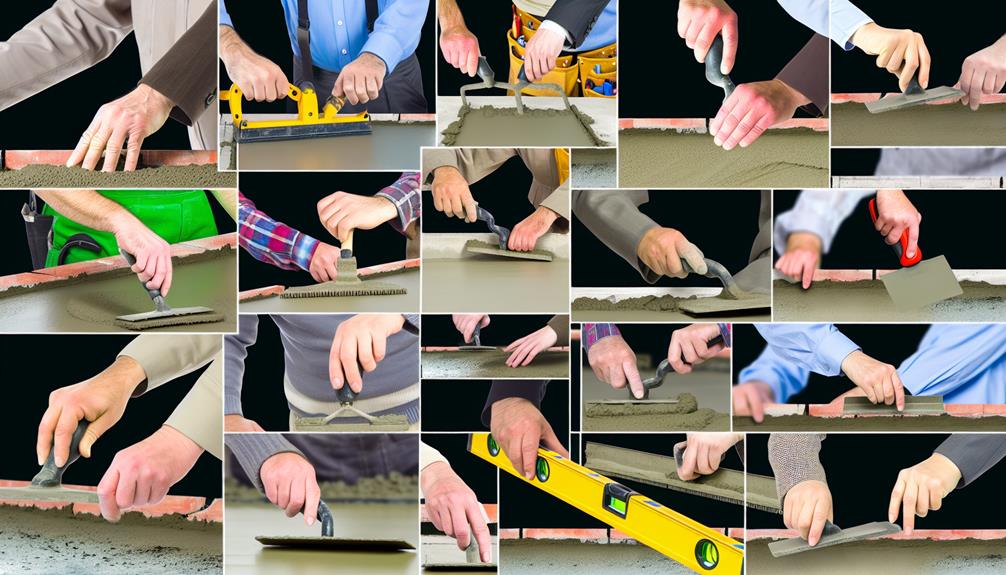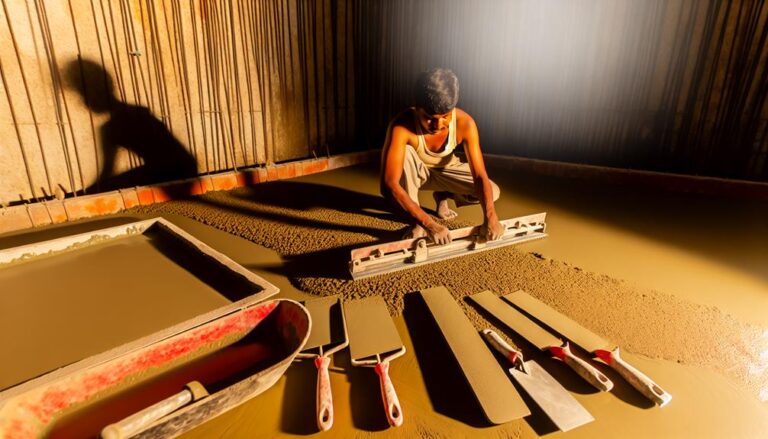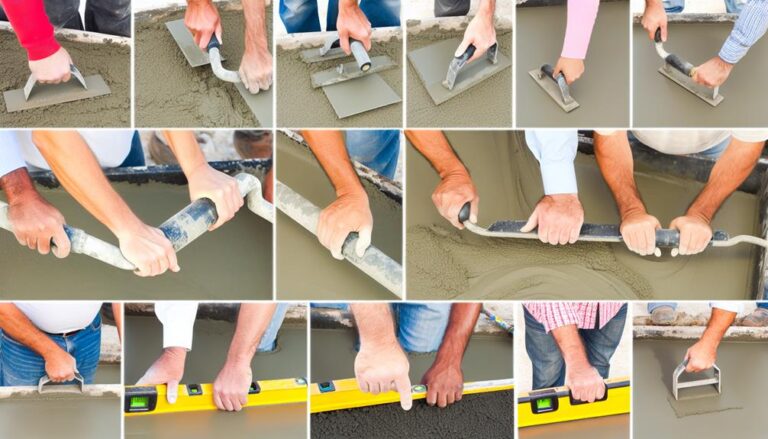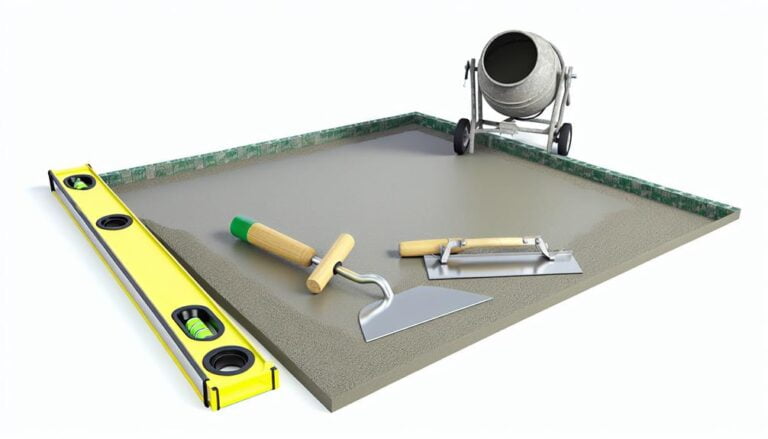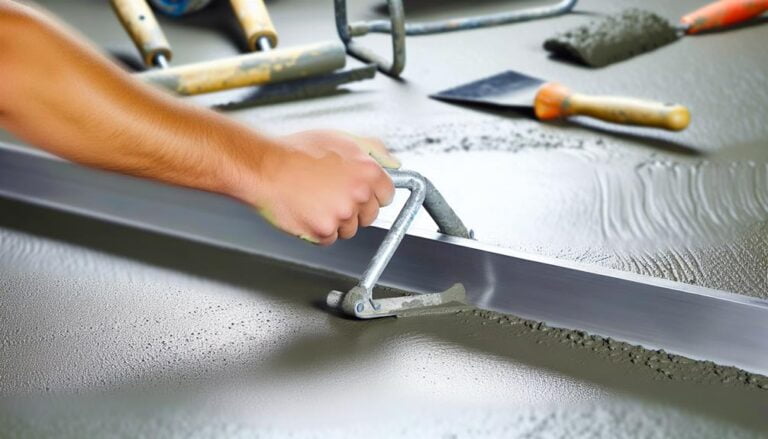7 Best Techniques and Tools for Professional Concrete Leveling
Top professional concrete leveling techniques include Mudjacking and Slabjacking. Mudjacking pumps a mix of water, soil, and cement under slabs while Slabjacking uses structural foam for faster curing. Key tools in your arsenal should be a bull float, concrete screed, edger tool, and concrete tamper. They'll smooth, level, and consolidate concrete, and prevent chipping. It's all about precision, knowledge – and safety gear. Stick around, there's still plenty to uncover about perfecting your concrete leveling game.
Understanding Concrete Leveling Basics
Before you dive into the specifics of concrete leveling techniques and tools, it's crucial to grasp the fundamental principles of concrete leveling. It's a process that corrects an uneven concrete surface by altering the foundation upon which it sits. The goal is to create a smooth, level surface.
The first thing to understand is that concrete can shift and sink due to a variety of factors. This could be because of soil erosion, poor compaction, tree roots, or even just natural settling over time. This can lead to cracks, uneven surfaces, and potential safety hazards.
Next, you need to realize that concrete leveling involves a few key steps. Firstly, you'll have to identify the problem areas. Then, drill holes into the uneven concrete slabs. Afterwards, a leveling compound or material, like sand or gravel, is pumped into the holes to raise and level the slab.
Importance of Professional Concrete Leveling
Recognizing the complexity of concrete leveling, it's essential to consider hiring a professional for the job. You might think it's just a matter of pouring and smoothing, but it's a lot more intricate.
Professional concrete leveling involves a high level of precision and expertise. It's not just about making the surface level, but it's also about ensuring the strength, durability, and longevity of the concrete. Professionals know how to mix the right proportions of cement, sand, and water, and they understand how temperature and humidity can affect the process.
Mistakes in concrete leveling can be costly. If it's not done right, you could end up with an uneven surface, cracks, or even structural damage. And fixing these issues can be more expensive than hiring a professional in the first place.
Moreover, professionals have access to the best tools and techniques. They can ensure a smooth, level surface that's ready for whatever you want to put on it, whether it's a driveway, patio, or building. So, while you might be tempted to do it yourself, hiring a professional for concrete leveling is a wise investment.
Top Techniques in Concrete Leveling
Now, let's delve into the top techniques used in concrete leveling, essential for creating a strong, durable, and even surface. This process is more than just pouring concrete. It's about precision, knowledge, and employing the right strategies.
First, there's the mudjacking technique, where a mixture of water, soil, and cement is pumped under the concrete slab to raise it to the desired level. This method's ideal when you're dealing with sunken or uneven concrete surfaces, and it's cost-effective too.
Then, we've got slabjacking, similar to mudjacking, but involves the injection of a structural foam instead. It's less messy and offers a quicker curing time. However, it's a bit more expensive.
Essential Tools for Concrete Leveling
Having discussed the top techniques, let's move on to the tools you'll need for concrete leveling.
First off, you'll need a good quality bull float. This tool is essential for smoothing and leveling the concrete surface. Make sure to pick one that's sturdy and comfortable to handle.
Next, a concrete screed is a must-have. It's used to level the concrete after it's poured, ensuring an even surface. You can choose between a manual or a power screed, depending on your project's size and your budget.
Don't forget the edger tool, which gives your concrete a professional finish by rounding the edges. This tool also helps prevent chipping and cracking.
A concrete tamper is another key tool. It helps push larger aggregate below the surface, which aids in leveling and consolidating the concrete.
Safety Measures in Concrete Leveling
When leveling concrete, it's crucial to prioritize safety to prevent accidents and ensure a successful project. This involves taking proactive steps to safeguard yourself, your team, and the environment.
- Use Proper Protective Gear: Always wear the right protective gear before starting any concrete leveling work. This includes safety gloves, eyewear, hard hats, and steel-toe boots. These items protect you from chemical burns, flying debris, and accidents involving heavy machinery.
- Maintain Your Equipment: Regularly inspect and maintain your tools and machinery. Poorly maintained equipment isn't just inefficient—it's also a safety hazard. Check for visible signs of damage or wear, ensure moving parts are lubricated, and replace worn out components promptly.
- Follow Safe Working Practices: Ensure everyone on the team understands and follows safe working practices. This includes proper handling of materials, correct use of tools, and adherence to safety guidelines. Regular safety briefings can be beneficial in reminding the team of these practices.
Case Study: Successful Concrete Leveling Projects
Let's delve into the realm of successful concrete leveling projects to illustrate the practical application of these techniques and tools. You'll find that the right methods and equipment can make all the difference in the quality of your work.
Consider a project undertaken in a commercial space where the concrete floor had sunk significantly. The team used slabjacking, a technique that involves pumping a grout mixture under the slab to raise it back to its original level. They used advanced leveling tools to ensure precise control of the rise, avoiding over-lifting that could result in further damage.
Another success story revolves around a residential driveway suffering from unevenness due to soil erosion. The team opted for polyurethane foam injection, a lightweight yet durable solution. They drilled small holes in the slab, injected the foam, and watched as it expanded, lifting the concrete to the desired level.
Both these cases highlight the importance of choosing the right tools and techniques for the job, based on the specifics of the site and the nature of the problem. These real-life examples demonstrate that with careful application and the right expertise, you can achieve excellent results in concrete leveling.
Maintaining Leveled Concrete Surfaces
Proper maintenance of your newly leveled concrete surfaces ensures their longevity and keeps them looking fresh and level for years to come. This isn't a one-time chore, but a routine you'll need to adopt if you want your concrete to withstand the test of time.
Here are three essential maintenance practices:
- Regular Cleaning: Dirt and grime can gradually wear down your concrete surfaces. Regular sweeping and washing can keep these elements at bay. For stubborn stains, consider using a mild detergent.
- Sealing: Concrete, by nature, is porous. Over time, water can seep into these pores causing cracks and damage. Sealing your concrete surface can help protect it from water damage, wear, and staining. It's recommended to reseal every few years.
- Repairing Minor Cracks Promptly: Even with the best care, concrete can develop small cracks. Don't ignore these. Instead, patch them up promptly to prevent further deterioration.
Maintaining your concrete isn't just about preserving its aesthetics; it's about extending its life. With these steps, you're not just keeping your concrete looking good, you're ensuring it stays strong and durable for a long time.
Frequently Asked Questions
What Are the Costs Associated With Professional Concrete Leveling?
The costs associated with professional concrete leveling can vary. Factors you'll need to consider include the size of the area you're leveling, the degree of unlevelness, and your location.
You'll also have to factor in labor and material costs. It's hard to provide a precise figure without specifics, but you could be looking at hundreds or even thousands of dollars.
We'd recommend getting a few quotes for a more accurate estimate.
How Long Does the Concrete Leveling Process Typically Take?
You're probably wondering how long the concrete leveling process takes.
It's not a quick fix; it can take anywhere from a few hours to a full day, depending on the size of the area and the severity of the problem.
Remember, professionals won't just be pouring new concrete.
They'll also need to prepare the area, level the concrete, and allow time for it to settle and dry.
Patience is key with this task.
Is It Possible to Perform Concrete Leveling as a DIY Project?
Sure, you could try DIY concrete leveling. It's just like making pancakes, right? Wrong! It's a complex process requiring specialized tools and know-how.
Without proper training, you could end up with uneven surfaces or damage your property. That's not even considering the safety risks.
What Are the Potential Environmental Impacts of Concrete Leveling?
Concrete leveling can have environmental impacts. It often involves heavy machinery, which can cause air and noise pollution. Additionally, the process might disrupt surrounding soil and vegetation.
If you're not careful, there's a risk of contaminating local water sources with concrete slurry. It's crucial you properly manage waste and use eco-friendly materials whenever possible. You also must comply with local environmental regulations to minimize any negative impacts.
What Kind of Training or Certification Is Required for Professional Concrete Levelers?
Surprisingly, you don't need a specific certification to level concrete professionally. However, it's crucial to have proper training. You'd typically start as a laborer and learn from experienced workers. Some companies might offer in-house training programs too.
Moreover, joining a trade union can provide access to apprenticeship programs. So, no formal 'degree' required, but hands-on training is essential to ensure you're doing the job right and safely.
Conclusion
So, you've been armed with the knowledge to level concrete like a pro. Picture yourself smoothing out rough surfaces effortlessly with the right tools in hand, using cutting-edge techniques.
Imagine the satisfaction when you see the flawless, leveled concrete, a testament to your hard work and precision. But remember, safety is paramount and maintenance is key.
Armed with these insights, you're ready to tackle any concrete leveling project that comes your way. Happy leveling!
